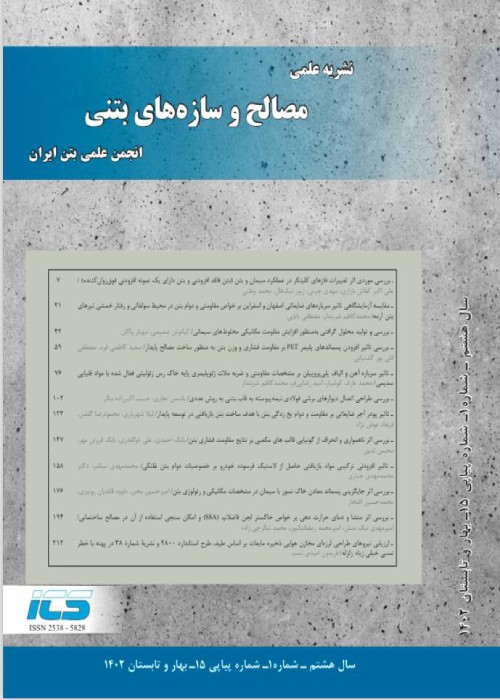Investigation of the Rocking Motion of RC Buildings Dual Shear Wall-Frame Structures
Author(s):
Article Type:
Research/Original Article (دارای رتبه معتبر)
Abstract:
The foundation is usually assumed to be rigid, in the design of buildings and the impact of soil type on the flexibility of the foundation is not directly applied in simulations. However, considering the interaction between soil and structure can affect the structure's response. On the other hand, shear walls are widely used in concrete buildings today. When these walls are affected by severe earthquakes, elevation and oscillating movements can be seen at the base of these systems. As a result, the foundations of these systems are lifted from the ground under certain conditions. In this study, the support conditions of columns and shear walls in concrete RC buildings with dual shear wall-frame were investigated. For this purpose, at first, an 8-storey concrete building with a dual RC shear wall-frame system was analyzed and designed in accordance with the national building regulations of Iran using SAP2000 software. In the next step, the outer frame of the structure was simulated using finite element method and ABAQUS software under two different boundary conditions. In the first case, the effect of the foundation was evaluated as rigid and in the second case, the effect of the foundation was evaluated with the possibility of lifting (creating a rocking motion). In order to consider the possibility of lifting the foundation and local-nonlinearity of the soil (creating a rocking motion) springs depending on the type of soil were defined with Bowles stiffness values. The variables include the type of boundary conditions, the strength of the concrete (C21, C40, and C60) and the type of soil (Clay, loose sand and dense sand). The results showed that considering the possibility of lifting the structure by a rocking motion depends on the characteristics of the soil under the foundation, so that the type of soil can play a role in stress, lateral displacement and base shear of the structure. Also, in frames where the boundary conditions of the column and shear walls were considered to be flexible, the change in soil type caused the maximum stress changes of the frame to reach about 60%.
Keywords:
Language:
Persian
Published:
Journal of Concrete Structure and Materials, Volume:5 Issue: 1, 2020
Pages:
183 to 199
https://www.magiran.com/p2158247
دانلود و مطالعه متن این مقاله با یکی از روشهای زیر امکان پذیر است:
اشتراک شخصی
با ثبت ایمیلتان و پرداخت حق اشتراک سالانه به مبلغ 1,390,000ريال، بلافاصله متن این مقاله را دریافت کنید.اعتبار دانلود 70 مقاله نیز در حساب کاربری شما لحاظ خواهد شد.
پرداخت حق اشتراک به معنای پذیرش "شرایط خدمات" پایگاه مگیران از سوی شماست.
اگر عضو مگیران هستید:
اگر مقاله ای از شما در مگیران نمایه شده، برای استفاده از اعتبار اهدایی سامانه نویسندگان با ایمیل منتشرشده ثبت نام کنید. ثبت نام
اشتراک سازمانی
به کتابخانه دانشگاه یا محل کار خود پیشنهاد کنید تا اشتراک سازمانی این پایگاه را برای دسترسی نامحدود همه کاربران به متن مطالب تهیه نمایند!
توجه!
- حق عضویت دریافتی صرف حمایت از نشریات عضو و نگهداری، تکمیل و توسعه مگیران میشود.
- پرداخت حق اشتراک و دانلود مقالات اجازه بازنشر آن در سایر رسانههای چاپی و دیجیتال را به کاربر نمیدهد.
In order to view content subscription is required
Personal subscription
Subscribe magiran.com for 70 € euros via PayPal and download 70 articles during a year.
Organization subscription
Please contact us to subscribe your university or library for unlimited access!


